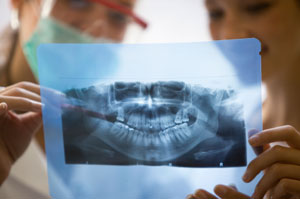Content Discussed Here
An apicoectomy is often referred to as a surgical root canal. To better explain, the tip of the tooth is referred to as the “apex” of the tooth, and the term “ectomy” means to excise or cut.
Therefore an apicoectomy can be defined as cutting or excising the tip of a tooth. The treatment is usually required when an individual has a “toothache” in a tooth that has already had a root canal procedure.
How Do I Know If I Need An Apicoectomy?
 Typically, an individual will complain of pain associated with a tooth that may occur with or without swelling. This would create the need to visit the dentist. The dentist will examine the patient and take the appropriate x-rays. If the toothache is identified as occurring in a tooth that has already received root canal treatment, then an apicoectomy may be required. The patient should then be referred to a board certified oral and maxillofacial surgeon for evaluation.
Typically, an individual will complain of pain associated with a tooth that may occur with or without swelling. This would create the need to visit the dentist. The dentist will examine the patient and take the appropriate x-rays. If the toothache is identified as occurring in a tooth that has already received root canal treatment, then an apicoectomy may be required. The patient should then be referred to a board certified oral and maxillofacial surgeon for evaluation.
Alternately, the patient may have no complaints at all, but the dentist may identify a new infection or cyst at the tip of a tooth that has already had a root canal treatment.
At Dolman Oral Surgery, Dr. Robert M. Dolman will carefully examine you and review the appropriate x-rays. He will determine at that time if an apicoectomy is the appropriate treatment or if alternate options are available.
What Are My Options Other Than An Apicoectomy?
If a “toothache” exists in a tooth that has already had a root canal treatment, or a new infection occurs in the absence of pain, then the first option may be to redo the root canal treatment which is referred to as a “retreatment.”
Dr. Dolman may refer you to an endodontist (root canal specialist) to accomplish a retreatment and help avoid the need for surgery.
Typical Apicoectomy Treatment Course
Once it has been determined that an apicoectomy is the appropriate treatment, Dr. Dolman will review the nature of the procedure and its associate risks/benefits and expected outcomes.
On the day of the treatment, you will be escorted into the treatment room and the required anesthesia will be provided. Local anesthesia is generally appropriate and if desired, Dr. Dolman is able to provide you with intravenous sedation to make your treatment as comfortable as possible.
Treatment will completed with both magnification and ultrasonic instrumentation – the industry’s highest standards.
After surgery, the patient will be observed in the office and discharged when appropriate. Follow up will be arranged for the following week. Typically, recovery is rapid with perhaps 1-3 days of minor swelling and discomfort. Patients can usually resume usual activities within 24 hours.
